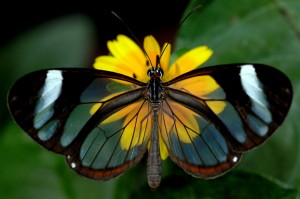As an urban ecologist, I’m fascinated by the ability of plants and animals to cope with the harsh city environment. In fact, habitats within the urban landscape can be surprisingly attractive to native wildlife.
But, just because something is attractive, doesn’t mean it’s good for you.

Cities can pose hidden risks to wildlife. In order to conserve biodiversity in the future, we need to understand whether or not urban habitats act as a safe refuge or an “attractive nuisance” for urban animals. Take, for instance, an abandoned lot that has been taken over by plants:
If you were a bird, this dense patch of vegetation would appear to be a green oasis amid endless streets and buildings. But, looks can be deceiving and birds can’t read the warning signs.

The two pictures above were taken at a brownfield, a property that has been abandoned due to pollution. Brownfields create a potential attractive nuisance by drawing animals in with the promise of plentiful resources, while at the same time exposing them to toxic chemicals. The brownfield pictured here is located in Jersey City, NJ. Past industrial use left the soil contaminated with elements called “heavy metals”.

Some of the heavy metals at the brownfield, like copper (Cu) and zinc (Zn), are known as micronutrients, meaning they are required by animals and plants in small amounts and are only harmful if too much is ingested. Others, like lead (Pb), are toxic even in low doses. Lead and Cd are known to concentrate as they move up the food chain, a process called biomagnification. This means that even if there’s only a little bit of toxin in an area where animals are feeding, a lot of it can end up concentrating in animals that are at the top of the food chain.

Scientists at the Jersey City brownfield have shown that some of the heavy metals in the soil are getting into the leaves of certain plant species and into birds. The heavy metals are transferred to the birds via their food: bugs. Bugs that eat the contaminated leaves, other bugs and spiders eat them, and birds eat all those things. But this is nothing new. Birds sit relatively high on the food chain and have been affected by the biomagnification of contaminants in the past.

What is new is that brownfields are weird and sometimes only moderately polluted. We don’t really know that much about the extent to which contaminants are transferred in these unusual ecosystems. At the Jersey City brownfield, it wasn’t clear whether or not the heavy metals were actually biomagnified in the food chain. This unanswered question was the focus of part of my PhD thesis. The only way to know the answer was to find out how much of the heavy metals are accumulating in the birds compared to their food.
Working with scientists from Rutgers University, I focused on house wrens, a small songbird that dines exclusively on insects and spiders. If the heavy metals are biomagnified in the food chain, this is what we expected to see:

A simple and non-invasive way to measure the amount of contaminants in a bird is to take feather samples. During the time of development, each feather is attached to a blood vessel, and therefore, acts as record of the amount of heavy metal in a bird’s blood during the time of feather growth. We gently removed breast feathers from nestling house wrens at the brownfield and safely returned them to their nest afterward (myth debunk: birds do not actually reject babies that have been handled by humans. If you see a baby bird on the ground, you can just put it back in the nest!). We also watched the nestlings to see what their parents were feeding them. Next, I collected insects and spiders to represent the birds’ food. To catch the small, fast-moving bugs, I used and aspirator (pictured below), which took some getting used to. Despite how it looks, the bugs didn’t actually end up in my mouth (thank goodness), but it made for a good contribution to a popular hashtag.
Collecting bugs through a straw at 5mo pregnant. Line up fellas, I'll cry if you don't #distractinglysexy pic.twitter.com/D7F5f4jhX5
— Megan Litwhiler, PhD (@MegClock) June 12, 2015
With the help of a fancy machine called an Atomic Absorption Spectrometer, we were able to determine the concentration of metals in the birds and their food. When we were watching the nestlings to see what they ate, we saw that they were fed quite a lot of spiders compared to insects. The spiders we tested had much higher levels of heavy metals compared to the insects we tested. Because spiders eat insects, it seemed that some heavy metals are in fact biomagnified at the brownfield. But, this didn’t continue on up to birds. The birds actually had lower levels of many elements compared to spiders, despite the fact that they are eating a lot of spiders! So, here’s what is really going on in this food chain:
All in all, this is good news for birds attracted to urban brownfields. A previous study at the Jersey City brownfield showed that the nestling wrens aren’t negatively affected by the contamination, and now my research has shown that this is in spite of that fact that they are eating contaminated food. So, these birds are highly tolerant of the perils of city living. Recently, researchers have explored the reuse of abandoned city properties, like brownfields, as habitats for birds threatened by urbanization. There is still more work to be done, but hopefully, my research will help inform urban planners as to how we can revitalize these sites as safe refuges for urban wildlife and places for humans to enjoy urban nature.





